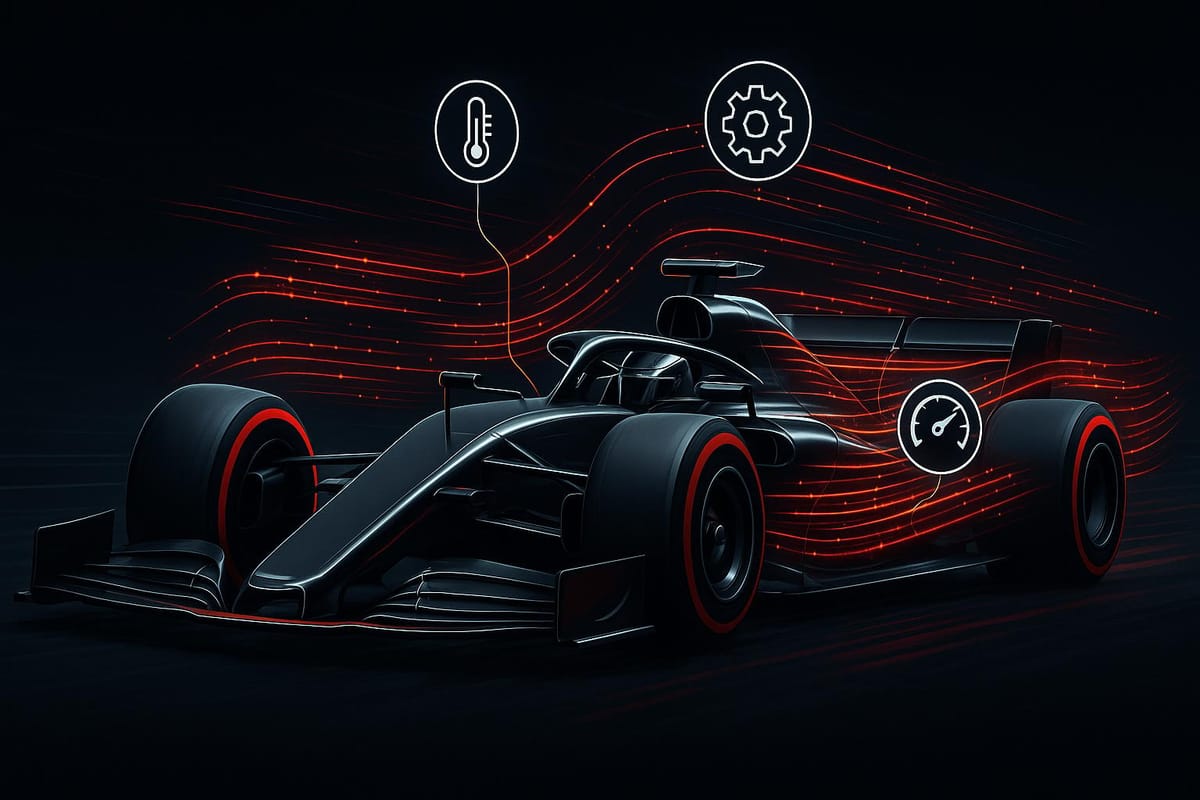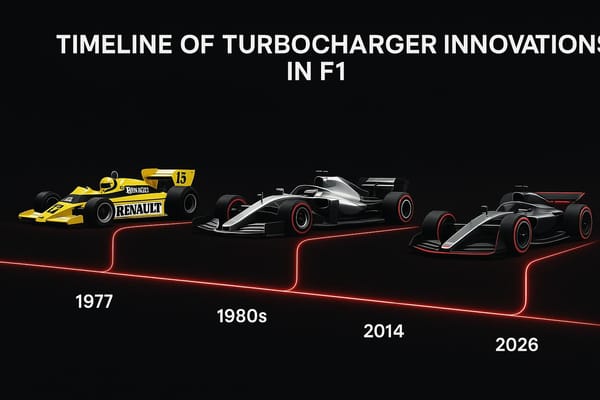How F1 Sensors Collect Data in Real Time
Explore how F1 cars utilize over 250 sensors to collect real-time data, transforming racing strategies and influencing automotive technology.

F1 cars generate 10,000 data points per second, making them advanced data hubs on wheels. This data, collected by over 250 sensors, helps teams make real-time decisions that can change race outcomes. From tire wear to engine temperature, sensors monitor every detail, producing up to 4 terabytes of data during a race weekend. This information is transmitted via telemetry systems with near-instant speed, ensuring teams can adjust strategies on the fly.
Key Highlights:
- Types of Sensors: Speed and motion (e.g., accelerometers), weather and airflow (e.g., pitot tubes), and driver safety (e.g., biometric gloves).
- Data Volume: 30MB per lap, 1.5 terabytes per race weekend.
- Telemetry: Wireless data transfer with latencies as low as 10–15 milliseconds.
- Applications: Real-time decisions (e.g., pit stops), post-race analysis, and technology transfer to road cars.
F1 sensors are not just about speed - they're about precision, safety, and strategy. Keep reading to explore how these systems work and their impact on both racing and everyday vehicles.
How Much Data Does an F1 Car Generate?
Main Sensor Types in F1
F1 sensors play a critical role in monitoring vehicle performance, external conditions, and driver safety. These sensors are typically divided into three categories: instrumentation, monitoring, and control. Let’s dive into the key sensors that fuel these real-time insights.
Speed and Motion Sensors
Accelerometers measure g-forces during sharp turns and braking, giving teams valuable data on how the car handles under extreme conditions. Damper potentiometers track how the chassis responds to compression and roll, while laser sensors measure ground clearance with precision. Dual-axis sensors keep tabs on braking forces and steering angles. Together, these sensors provide data that teams use to fine-tune car setups and adjust driving strategies on the fly.
Weather and Air Flow Sensors
Pitot tubes are used to measure airspeed, while other sensors monitor engine and airbox temperatures. These tools help teams respond quickly to environmental factors that could impact performance.
| Weather Impact on Performance | Effect |
|---|---|
| Headwind (≈12 mph) | 13.8% increase in downforce at approximately 200 mph |
| Tire Temperature Variation | Up to 0.1 seconds per lap difference |
| Wet Track Conditions | Tires disperse 80+ liters of water per second |
"For Formula 1, our job is to create and disseminate weather forecasts so localized that they could apply to people's gardens!"
- Paul Abeillé, forecasters-advisors at Météo France Sport
Driver and Safety Sensors
In addition to performance monitoring, safety sensors are crucial for protecting drivers and maintaining system integrity. The Accident Data Recorder (ADR) continuously logs incidents and alerts teams when necessary. Biometric gloves track vital signs such as pulse and blood oxygen levels, providing real-time health data. Pressure sensors monitor the hydraulics and brakes, while ultrasonic fluid flow sensors ensure fuel performance is optimal.
"We know that the monitoring of people is essential in terms of their medical care and drivers in incidents are no different. We would like to start monitoring and assessing them as soon as we possibly can. There are also times when the driver isn't immediately accessible to us, so if we can't see him or we're not actually next to him, there's limited information that we can get."
- Dr. Ian Roberts
Sensor Locations on F1 Cars
Modern Formula 1 cars are outfitted with more than 250 sensors, strategically placed across the chassis and components. These sensors work together to deliver real-time performance data, giving teams a crucial edge during race weekends. Let’s take a closer look at where these sensors are located and what they monitor.
Body and Suspension Sensors
The car’s body and suspension system are packed with sensors designed to measure forces and impacts during a race. For instance, damper potentiometers track spring compression and chassis roll, offering insights into how the car handles under high downforce. Beneath the chassis, laser sensors measure ground clearance, while accelerometers scattered throughout the body record g-forces during sharp turns and sudden maneuvers. Together, this network of sensors generates around 30MB of data per lap, with vibration data captured at an impressive rate of up to 200,000 samples per second.
Wheel and Brake Sensors
When it comes to braking and deceleration, specialized sensors focus on the performance of the wheels and brake system. Temperature sensors embedded in the brake discs monitor heat levels, which can soar to a scorching 1,000°F during heavy braking. McLaren employs an innovative method using heat-sensitive stickers on brake drums to measure surface temperatures. These insights help engineers fine-tune front wing settings or adjust brake duct designs to ensure effective cooling.
| Brake System Monitoring | Typical Range |
|---|---|
| Deceleration Force | Up to 5G |
| Brake Disc Temperature | Up to 1,000°F |
| Data Generation | 30MB per lap |
Wing and Body Sensors
The aerodynamic surfaces of the car are equipped with sensors that track airflow and pressure distribution. Pressure tappings - small holes connected to transducers - are placed in areas with high-pressure gradients and suction peaks to monitor static pressure. Additionally, aerodynamic rakes fitted with pitot tubes measure total pressure across the car’s body, helping teams visualize airflow losses in detail. These sensors feed data to the Electronic Control Unit (ECU) via analog systems or CAN network buses, collectively producing over 1 terabyte of data during a race weekend.
Data Transfer and Analysis
F1 cars don't just race; they gather and transmit an extraordinary amount of data. Modern F1 vehicles generate a staggering 1.1 million telemetry data points every second through their onboard sensors. But collecting this data is only part of the equation - how it’s transferred and analyzed can make or break a team’s performance.
F1 Telemetry Systems
Every F1 team operates with the same telemetry system, which relies on a network of trackside antennas to wirelessly transmit data at 1.5 GHz. This system achieves impressively low latencies: just 10–15 milliseconds in Europe and 300–400 milliseconds in other regions. Such speed ensures real-time data flows seamlessly between the cars and the teams' analysis tools.
"The telemetry system is common across all the F1 teams, so there's quite a big infrastructure around the racetrack to ensure we get 100% coverage. That system is common to all the teams, a unique example of cooperation between the F1 teams."
- Evan Short, Team Leader of Trackside Electronics Systems at Mercedes F1
This shared system is a rare example of collaboration in a sport known for its fierce competition, ensuring every team has reliable data coverage throughout a race.
Data Display and Analysis Tools
In a typical 90-minute session, each car produces between 5 and 6 GB of compressed telemetry data. This data is transmitted through 1,000 to 2,000 telemetry channels, giving engineers the insights they need to make split-second decisions about strategy. These tools transform raw sensor data into actionable strategies that can impact race outcomes.
"During practice or a qualifying session, the drivers are keen to see their performance and compare it to their teammate's. So, going through that data with the performance engineer is a vital part of practice sessions, and in particular, the qualifying session when there's a short time in between runs to try and understand where the critical areas of time losses are and where they can gain performance on the next run."
- Chris Nelson, Trackside Control Systems Engineer
This process helps drivers and engineers identify performance gaps and refine their approach in real-time, especially during high-stakes qualifying sessions.
Data Transfer Limitations
Despite the advanced technology, teams must navigate strict FIA regulations that govern data sharing and communication frequencies. To handle potential signal interruptions, each car buffers its most recent data onboard and retries transmission automatically if needed. Across a single Grand Prix weekend, each car generates roughly 500 GB of data, pushing the limits of processing systems to deliver fast, accurate decisions.
Managing this massive volume of data while adhering to regulatory constraints is a balancing act, but it’s one that F1 teams have mastered to maintain their competitive edge.
Using Sensor Data in F1
Race-Time Decisions
F1 teams rely heavily on real-time sensor data to make crucial decisions during races. By constantly monitoring factors like tire pressure, engine temperature, and brake status, teams can fine-tune strategies, such as determining the perfect moment for a pit stop.
"By tapping into the breadth and depth of AWS and its innovative cloud technologies, we've been able to bring fans closer to the split-second decisions on the track, redesign our future F1 cars, better understand the wealth of F1 data, and run analytics and machine learning." - Ross Brawn, Managing Director of Motor Sports, F1
After-Race Learning
The work doesn't stop once the race is over. Teams dive into an extensive review of telemetry, video footage, and performance data to refine future strategies and car designs. On average, each race generates around 400 GB of data for analysis.
"The drivers are keen to understand all this data even away and out of the car. Typically, on a Friday evening, they will review their data to understand their performance and get an overall feel for what the car is doing to back up their observations and feelings from within the cockpit." - Chris Nelson, Trackside Control Systems Engineer
A practical example of this came during the 2022 Melbourne Grand Prix. Engineers used sensor data to detect an engine overheating issue and promptly advised George Russell to cool the car by adjusting his driving during turns.
Impact on Road Cars
The advancements made on the track don’t just stay in F1 - they make their way into everyday vehicles. Sensor technology and data analysis techniques developed in F1 influence consumer cars, improving safety features and enhancing performance.
"Racing is always about going the extra mile and looking for the most sophisticated technical solution. That opens your mind for technologies you would not think of first for a [consumer] car." - Jochen Hermann, chief technology officer at Mercedes-AMG
A great example of this is the 2024 Mercedes-AMG C63 S, which incorporates hybrid technology inspired by F1. This innovation not only boosts power output but also improves fuel efficiency.
Conclusion
F1 sensor technology has transformed how teams make decisions, allowing for split-second, data-driven strategies. With over 250 sensors capturing 10,000 data points every second, a single race weekend generates a staggering 1.5 terabytes of data. This reliance on data continues to reshape strategies on the track.
"Everything we do is data driven. It's always about data, and it's always about planning ahead."
- Zoe Chilton, Head of Technical Partnerships at Aston Martin Red Bull Racing
What’s Next for F1 Sensors?
The future of F1 sensors is set to evolve further with the integration of artificial intelligence and machine learning. Teams are increasingly relying on data scientists to leverage predictive analytics, with results already influencing race outcomes.
"Oracle Cloud is playing a key role in the outcome of every single Grand Prix that we've won this year and every Grand Prix where we've achieved significant results."
- Christian Horner, CEO of Oracle Red Bull Racing
Some key areas of development include:
- Predictive Analytics: Machine learning algorithms are being used to fine-tune real-time performance strategies.
- Safety Systems: Advanced ADRs (Accident Data Recorders) now provide instant alerts during incidents.
- Energy Efficiency: Thermal efficiency has seen a massive leap, climbing from 29% during the V8 engine era to over 50% today.
"We're going with prototype cars that are changing nearly race-on-race … different tracks, different tires … the right way of doing that is to use modeling tools that will run millions of race scenarios"
As these innovations continue to push boundaries, their influence is expected to spill over into everyday automotive technologies, making the advancements in F1 relevant far beyond the racetrack.
FAQs
How do F1 teams ensure data from over 250 sensors is accurate and reliable during a race?
F1 teams rely on sophisticated telemetry systems to manage data from more than 250 sensors, ensuring both accuracy and reliability. These systems transmit real-time data straight to the pit crew, and they're built with backup mechanisms to reduce errors and maintain consistent functionality, even in high-pressure, extreme environments.
Before every race, sensors go through extensive calibration and testing to guarantee precise measurements. The data is then encrypted and securely transmitted to the pits, where engineers analyze it on the spot to make critical decisions. This thorough process enables teams to handle over 1.5 terabytes of data during a single race weekend, providing the crucial insights needed to refine strategies and enhance performance.
What challenges do F1 teams face when transmitting real-time data during a race?
Transmitting real-time data during an F1 race is no small feat. Each car churns out an astonishing 10,000 data points every second, all of which need to be sent to the team almost instantly. The challenge lies in handling this sheer volume of information while keeping delays to an absolute minimum.
On top of that, telemetry systems must be rock-solid when it comes to security. If data were intercepted or tampered with, it could completely derail a team's strategy. And then there’s the physical environment - racetracks are full of potential obstacles, from signal interference to connectivity disruptions caused by surrounding structures or competing signals.
To tackle these hurdles, F1 teams turn to cutting-edge solutions like encrypted communications and high-speed networks. These technologies ensure the data stays secure, reliable, and fast - critical factors when every millisecond counts on the track.
How does F1 sensor data shape the technology used in everyday cars?
Data from F1 sensors has a huge impact on the technology found in everyday cars, pushing progress in areas like hybrid powertrains, aerodynamics, and materials science. Take F1’s hybrid power units as an example. These systems, including KERS (Kinetic Energy Recovery System), capture and reuse energy, a concept that’s directly shaped the evolution of hybrid and electric vehicles, making them more efficient and eco-conscious.
Aerodynamics is another area where F1 has left its mark. Lessons learned on the track have influenced road car designs, helping to cut drag, boost fuel efficiency, and enhance stability. Then there's carbon fiber - originally crafted for F1 cars - which has found its way into consumer vehicles. This advanced material makes cars lighter, safer, and more efficient. These examples highlight how high-performance racing technology translates into real-world improvements for everyday drivers.




